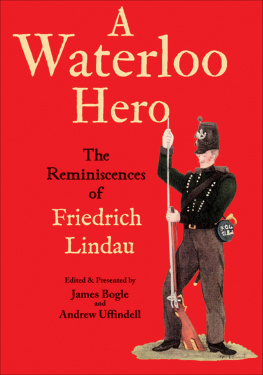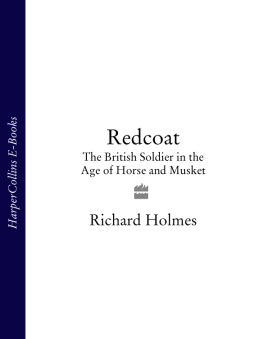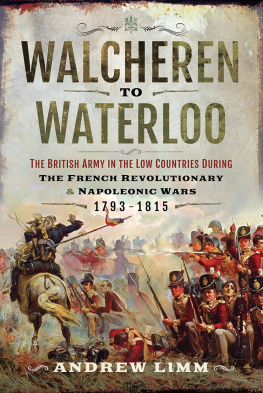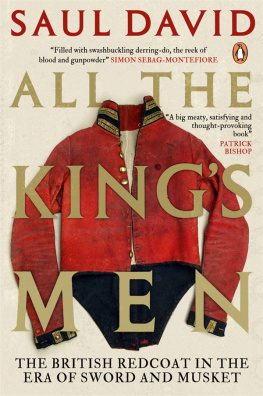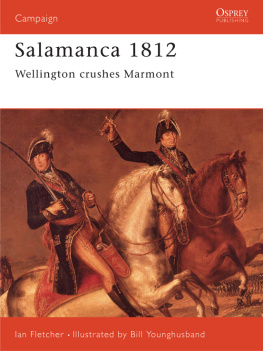
Publishing note
The original German edition was published in Hamelin in 1846,
under the title of Erinnerungen eines Soldaten aus den Feldzgen
der Kniglich-deutschen Legion (Reminiscences of a soldier from the
campaigns of the Kings German Legion), with a foreword by Franz
Georg Ferdinand Schlger. Now published for the first time in
English, this edition includes a new introduction by the translator,
James Bogle, and explanatory passages by Andrew Uffindell. The
chapter headings, subheadings, maps and notes have also been
added.


A Waterloo Hero: The Reminiscences of Friedrich Lindau
This edition published in 2009 by Frontline Books, an imprint of Pen &
Sword Books Limited, 47 Church Street, Barnsley, S. Yorkshire, S70 2AS
www.frontline-books.com
Copyright Pen & Sword Books Ltd, 2009
Introduction James Bogle, 2009
ISBN: 978-1-84832-539-5
Digital Edition ISBN: 978-1-78346-163-9
The Publisher would like to thank Gareth Glover for his support in the
production of this book.
All rights reserved. No part of this publication may be reproduced, stored
in or introduced into a retrieval system, or transmitted, in any form, or by
any means (electronic, mechanical, photocopying, recording or otherwise)
without the prior written permission of the publisher. Any person who does
any unauthorized act in relation to this publication may be liable to criminal
prosecution and civil claims for damages.
A CIP data record for this title is available from the British Library.
For more information on our books, please visit
or write to us at the above address.
Typeset by JCS Publishing Services Ltd, www.jcs-publishing.co.uk
Maps drawn by Red Lion Prints
Printed in the UK by the MPG Books Group
M APS
T RANSLATOR S I NTRODUCTION
The circumstances that led me to make this translation of Friedrich Lindaus Reminiscences are rather unusual. I knew from my family records that my great-great-grandfather, Jacob Ole Lindam [sic], who was born a Dane, had served as a young officer in the Kings German Legion for the greater part of the Peninsular War and at Waterloo under the command of the Duke of Wellington. I wished to research the role of the Legion in this campaign and I was led by the British Library catalogue to a book published in German in 1846, the reminiscences of a private soldier in the 2nd Light Infantry Battalion of the Legion. I knew that Ole Lindam (as he was generally known) also served in this battalion. When I began to translate I found a very telling vivid narrative, so in the course of time I grew familiar with the whole book. It was with considerable pleasure that I found out that Ole Lindam was Lindaus company commander (No 1 Company, 2nd Light Infantry Battalion, Kings German Legion) and that he was twice mentioned by name in the narrative and may have been referred to on other occasions simply as my captain. So I have a personal connection with the book.
Lindaus Reminiscences is one of the very few accounts of the Peninsular Campaign given by a private soldier in the Kings German Legion. The narrative was presented without any breaks (the chapter headings and subheadings are added). Lindaus memories were recorded with the help of a pastor, Rector Hansen. Lindau was illiterate and so his Reminiscences were dictated. Although there were thirty years or more between the events recorded and the publication of the book Lindau generally seems to have had a very good memory of the happenings he witnessed, though there are a few minor discrepancies, and his narrative tallies well with the standard history of the Kings German Legion by North Ludlow Beamish and also with the account of his commanding officer at the defence of the farmstead of La Haye Sainte at Waterloo, Major George Baring, who singled out Lindau for his courage the only private soldier that he mentioned. One may suppose that the ordinary soldiers had little idea of the campaign as a whole. Rather plaintively Lindau remarked of the retreat from Burgos in 1812:
I was made angry that we continuously had to fall back before the enemy, who could well think that we were afraid of them, which was by no means the case. If it had depended on our battalion we would not have let ourselves be driven back even one foot by the whole of the French army, but the commands of the superiors must be obeyed by the soldier even if against his will.
Friedrich Lindau was christened Georg Friedrich Wilhelm at Hamelin Garrison Church on 19 January 1788. His father, August Wilhelm Valentin, served as a soldier in the Hanoverian service for twenty-three years as a lance-corporal; on discharge from the army he worked as a weaver. He was a strict disciplinarian. Two of Friedrichs godfathers were also soldiers. His mother, Hanne Christiane Sophie Rudolph also came from Hamelin. Friedrich had five sisters and two brothers: the older brother, Georg Ludwig, born in 1789, served in the Kings German Legion like Friedrich, but as a butcher; and the younger, Christian Wilhelm, born in 1792, served in the Legion as an artilleryman.
As a youth Friedrich was confirmed before being put as an apprentice to a shoemaker, his lifetimes trade, but as his master treated him harshly he ran away. Another master took him on as a shoemaker, but mostly employed him on other business so that even after leaving the army he still had to complete his training for his trade. Friedrich long desired to go to England to join the army and finally ran away from home on Martins Day, 4 July 1809. He was hotly pursued by his brother Christian, who had to be forcibly deterred from coming too, though he was able to join up later. After an adventurous journey Lindau arrived in Harwich on 27 July. He marched with other recruits to the Unattached Recruits Depot at Lymington, then on 5 August marched to Bexhill where he arrived on the 17th. He was formally enlisted on 24 August to join the 1st Company of the 2nd Light Infantry Battalion of the Kings German Legion as a rifleman (private soldier); he signed on for seven years and received his bounty of four guineas. His description on recruitment was blue eyes, blond hair, fair complexion and height 5 7 (his discharge papers gave his height as 5 9).
The years of Lindaus service are fully covered in the narrative.
Lindaus name was included in the Muster Roll of those who served at the Battle of Waterloo and in due course he was awarded the Waterloo Medal; he was also awarded the Guelphic Medal, a tribute to his courage at the Siege of San Sebastian and in the defence of La Haye Sainte at Waterloo. He obtained his discharge from the army from his commanding officer George Baring (by then a lieutenant-colonel) on 24 October 1815 at the Bois de Boulogne in Paris. His papers noted that he had served for eight years and two months; he actually served for six years and two months Waterloo counted for an extra two years of service. The discharge paper records that he was severely wounded at Vitoria and Waterloo. The Guelphic Medal carried a pension and in addition in 1820 he was recommended for a pension from the Royal Hospital Chelsea in respect of the wound to his right arm at the Battle of Vitoria.
After his return to Hamelin Lindau resumed his work as a shoemaker and married. His wife died in 1827 but he married a second time. By 1846, when the Reminiscences were published and Schlger wrote his foreword, there is a strong suggestion that Lindau had fallen on hard times. Schlger draws attention to Lindaus nine children, of which four were still at school mouths to feed. Were it not for his pensions he would have very little income for his business was not prospering. Doubtless one of the reasons for the publication of the Reminiscences was to afford him some financial relief. In 1849 Lindau received the (English) Military General Service Medal (Peninsular War Medal), which he signed for; Lindau qualified for six clasps: Albuera, Salamanca, Vitoria, San Sebastian, Nivelle and Nive. In 1865 a list was made of soldiers in Hamelin still alive who had fought in the years 181315; Lindaus name does not appear among them, so it must be taken that by then he had died.

